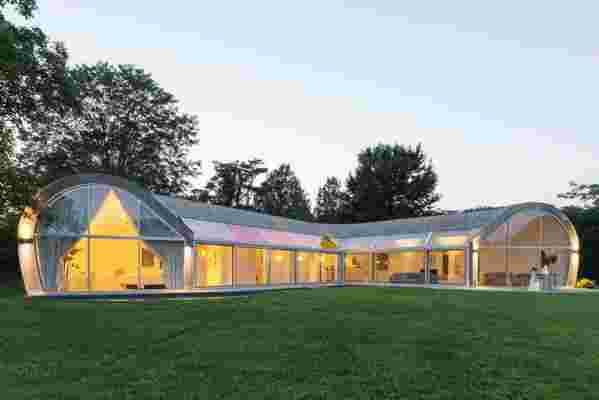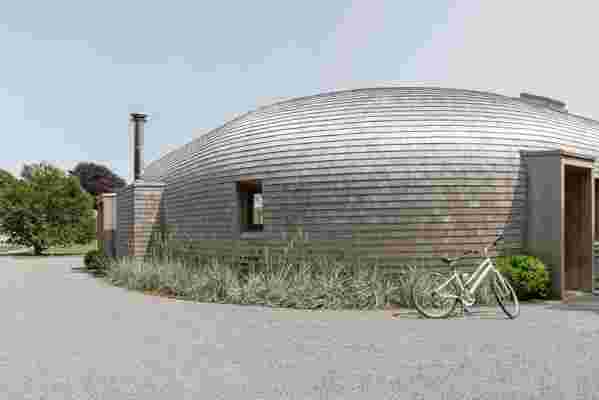Don’t let the multicolored skylights, minimal interior, or space-age curved design fool you: At its heart, Cocoon is a simple family beach house. For architect Nina Edwards Anker, her husband, and their two sons, who primarily live in Manhattan’s Greenwich Village, it is the perfect antidote to city life. It’s a place to relax, unplug, host friends for casual cookouts, and get back in touch with nature, but the design is the culmination of years Edwards Anker has spent pondering the relationship between architecture and the sun.
The house’s unique shape is intended to maximize daylight and solar energy, while the colored skylights help the family stay in tune with the sun’s natural rhythms. Laid out in the shape of an L, the inside walls face the south and are made entirely of glass, filling the house with light and views all year long. The back wall wraps around the spacious windows, forming the namesake cocoon and storing the sun’s heat through the night. Edwards Anker is hopeful that the passive heating, along with touches like rainwater recycling and native plants, will eventually earn the home LEED certification.

An exterior view of the home reveals the L-shape design.
Achieving its unusual rounded shape was no easy feat; expert carpenters had to frame out the house as they might the hull of a ship, with both vertical and horizontal beams curving to create an organic, nestlike shape. It is clad in gray cedar shingles, a local material that complements the native beach grasses Edwards Anker has planted along the driveway. Over time, the shingles will age and weather, further blending the home into the landscape.
“One of the questions I kept coming back to when designing the house was, how do you tie everyday living to ideas about the sun?” says Edwards Anker, who counts Olafur Eliasson, Peter Zumthor, and artist James Turrell among her influences. Her solution was not only to orient the house toward the sun, but to install colored skylights that act as a kind of sundial to attune the family to the fluctuations of light throughout the day and the year. “In the winter,” says Edwards Anker, “the yellow triangle hits the back of the kitchen at nine a when I am making breakfast. In the summer, I wake up at seven o’clock to read or meditate. The little red triangle is at the beginning of the wall, where the plant is, and by 7:30 it’s moved to where the bathtub is.”

The gray cedar shingles will, over time, age and weather, further blending the home into the landscape.
The skylights are arranged from cooler colors in the kitchen to warmer colors as they lead toward the bedroom, based on the German poet Johann Wolfgang von Goethe’s theory that yellow represents daytime activity, and warmer tones like red should signal rest.

A look at how the skylight changes the interior from the bedroom to the living room.
Light and sustainability are twin passions for Edwards Anker, whose design practice, nea studios , has been focused on crafting chandeliers out of dried seaweed and cut seashells. Three of these fixtures are on display in Cocoon House, where they hang like glowing jellyfish or bunches of sea grapes, adding to the minimalist but beachy vibe. Light sensors and photovoltaic panels allow them to keep time with the sun’s natural clock. “The lights underline the rhythm of sunset,” adds Edwards Anker. “They come on around 7:30 in the summer and 5 in the winter, and that illumination happens at different times of day throughout the year.”
The ultimate resource for design industry professionals, brought to you by the editors of Architectural Digest
The house is located on a plot of land Edwards Anker shares with her brother, which is also occupied by a house her parents bought when she was a child—Cocoon House is technically a guesthouse, so its height and footprint were restricted by local zoning codes—so creating a space where her children can connect to family and the environment was priority number one. “Those local plants, the beach grass, wisteria, and beach plums, they smell like something," she explains. “And that’s another way of connecting deeply with the space through memory and the senses.”
Edwards Anker says that her focus is on creating an alternative to cookie-cutter sameness, the hedges and manicured lawns typical of the Hamptons: “This home is not just an empty space, it’s a place that has its own character, and that is linked to the health of the ecosystem.”
